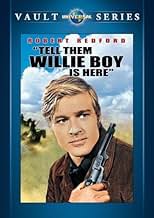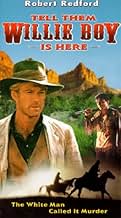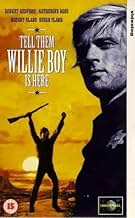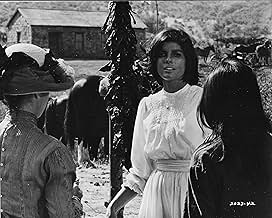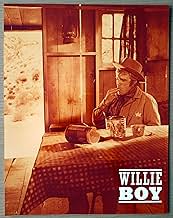In 1909, when young Paiute Indian Willie Boy returns to his California reservation to be with Lola, whose father disapproves of him, a killing in self defense takes place, triggering a massi... Read allIn 1909, when young Paiute Indian Willie Boy returns to his California reservation to be with Lola, whose father disapproves of him, a killing in self defense takes place, triggering a massive man hunt for Willie.In 1909, when young Paiute Indian Willie Boy returns to his California reservation to be with Lola, whose father disapproves of him, a killing in self defense takes place, triggering a massive man hunt for Willie.
- Director
- Writers
- Stars
- Won 2 BAFTA Awards
- 3 wins & 1 nomination total
- Digger
- (as Eric Holland)
- Meathead
- (as Lee De Broux)
- Director
- Writers
- All cast & crew
- Production, box office & more at IMDbPro
Featured reviews
yes, it raises all the cross-culture misunderstandings, thats what makes it so tragic and so good. it makes you stop and think before you make that next assumption about someone you don't know....whose culture your only vaguely familiar with..not a bad thing to do today, then or anytime.
Every scene is painfully slow in getting to the payoff so that the film seems a lot longer than one hour and thirty-six minutes. The first hour is devoted to the manhunt for an Indian killer (Blake) and then the plot involves the arrival of President Taft in 1909 California and the effort to protect him from any kind of assassination attempt.
Redford's role as the reluctant sheriff is never too clear since he's a man of a very few words (a regular Gary Cooper type), so it's up to Blake to carry much of the film and he does. He's terrific as the Indian lad who's trigger happy when the posse starts getting too close.
The last twenty minutes should have been a model of suspense as they close in on Willie Boy, but it's allowed to drag out interminably.
Summing up: Character driven tale had the potential to be a fine western, but badly paced direction of Abraham Polonsky is no help nor is the sluggish script. Film was released after BUTCH CASSIDY AND THE SUNDANCE KID put Redford on the map but was never a big box-office success.
Director Abraham Polonsky was making his comeback to mainstream cinema with this film, eighteen years after being blacklisted by the UnAmerican Activities Committee. He also wrote this screenplay, which strikes a defiant note in favour of the lone hero against the forces of intolerance and repression. It is not too fanciful to see the indians, with their alternative sensibility and distinct code of values, as a metaphor for artists and free thinkers. Minorities are always in danger, suggests the film, from the urge to hound and victimise manifested by some elements in society.
Polonsky skilfully uses the camera to tell his story. We follow the complex movements of the various characters around the fiesta fairground without the need for spoken dialogue. The silent meeting of Coop and Willie tells us everything about these two men, and their mutual rivalry and respect.
The wonderful topography of the Mojave Desert is superbly captured in Panavision. In particular, the showdown on Ruby Mountain offers some gorgeous images. The film's four leads are excellent: Robert Redford is a wise and humane Coop, the sherriff obliged to lead the inappropriate manhunt: Robert Blake is perfect as the nihilistic, elemental Willie: Doctor Elizabeth Arnold is played by Susan Clark, developing nicely the ambivolence of a woman who needs Coop sexually but despises herself for it: Katharine Ross is the spry, athletic Lola, the young indian girl who becomes Willie's 'wife by capture'.
The title role of Tell Them Willie Boy Is Here is played by Robert Blake who is a Paiute Indian kid who by their tradition kidnaps the women of his intentions Katherine Ross to make her his bride. It's their way of courtship, but when Ross's dad objects he's accidentally shot and killed by Blake.
Ironically with a good lawyer Blake might have gotten off. But Paiute Indians usually don't get good lawyers and they don't take to confinement. Still this incident might have gone unnoticed but for the fact that the sitting president of the USA in 1909 one William Howard Taft was visiting the area. That brings in the national media and blows up the story.
Robert Redford plays the sheriff charged with bringing in Blake dead or alive. He never played quite the roughneck character he does in this film than in any other work I can recall. Susan Clark plays the doctor on the Paiute reservation who has her views routinely ignored as she's mansplained on a regular basis. She also has her needs fulfilled by Redford as both are the best of what's out there in their corner of the world.
It's Blake and Ross who really capture your attention. I'm sure that William Shakespeare would have seen so readily the parallels between his timeless classic and what Blake and Ross are all about.
Blake's character is a Paiute Indian who is the object of a manhunt which is sensationalized by the press because of its concurrence with a visit by President Taft. The sheriff is pressured into hunting down the Indian and the girl he loves but whose father has forbidden the match.
It's a good solid early-1900s Western with much better-than-average acting. But it's not so much an action film as it is a character study -- of Blake's character and, to a lesser degree, Redford's. It brings to life the racism and exploitation that white Europeans brought with them to America.
Did you know
- TriviaAbraham Polonsky said to a USC film class at the time that he purposely shot and edited the manhunt sequences with characters moving in all directions across the screen, rather than in the usual way wherein both runners and pursuers would move in the same direction across the shots (i.e., left to right) to enhance the impression of urgent suspense in a chase. Instead, Polonsky was looking for a different feel for the audience, of the characters wandering, feeling their way through the landscape. He implied he was willing to sacrifice some suspense to externalize the characters' confusion. He also said that for Katharine Ross' brief, artfully lit nude shot, he exposed the film correctly but then produced a high-contrast copy of the same film frames with deep blacks and transparent lights, then bi-packed both pieces of films together to rephotograph. The high-contrast overlay ensured that the shadows on Ross' body were black--so that the image could not reveal more in the shadows than it was supposed to.
- GoofsMany of the hats worn in the film are not the style worn during the early part of the 20th century. Some in fact, could only have been sewn using machines created in the 1950s, nearly half a century after the film's setting.
- Quotes
Dr. Elizabeth Arnold: Willie killed Mike and took Lola. They call it marriage by capture. The mother knew that and told her to go.
- ConnectionsFeatured in Red Hollywood (1996)
- How long is Tell Them Willie Boy Is Here?Powered by Alexa
Details
- Release date
- Country of origin
- Language
- Also known as
- Tell Them Willie Boy Is Here
- Filming locations
- Pioneertown, California, USA(shoot out near end, Pipes Canyon)
- Production company
- See more company credits at IMDbPro
Box office
- Gross worldwide
- $5,949
- Runtime
- 1h 38m(98 min)
- Color
- Aspect ratio
- 2.39 : 1


